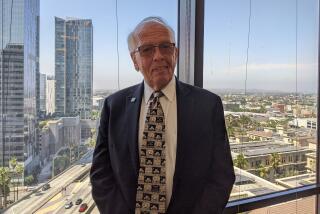Prescription for Survival : O.C., Southland Doctors in Ethnic Areas Network to Survive HMO Era
- Share via
After completing their training at UC San Diego’s School of Medicine, Drs. Nwachukwu and Vicki Anakwenze opened a medical clinic in a renovated former nightclub across the street from the poverty-stricken Nickerson Gardens housing project in Watts.
“We wanted to have an impact,” said Nwachukwu. “We felt that Watts had the greatest need and the largest collection of sick people.”
Working nights and weekends over the past decade, the Anakwenzes (pronounced ANA-QUINCYS) have grown a thriving practice that includes their three Quincy Care Medical Clinics and 25,000 patients.
But they are now worried that the practice they have worked so hard to build is imperiled. Increasingly, their patients’ employers are pushing them into health maintenance organizations, which require them to go to the HMO’s own doctors and clinics. The Anakwenzes have never done business with HMOs.
Another cause for concern is the state Department of Health Service’s decision to double managed-care enrollment among the state’s roughly 5 million Medi-Cal beneficiaries by 1995. Sixty percent of the Quincy clinics’ patients receive Medi-Cal benefits. The Anakwenzes fear they will lose their Medi-Cal patients as they are snagged by large managed-care groups.
The Anakwenzes have responded to this threat by forming a large network of doctors that, if successful, would use its strength in numbers to land managed-care contracts. Although networks of doctors of all stripes have grown dramatically in the past decade nationwide, the Anakwenzes’ group is still a rarity: a minority-owned physician network that serves inner-city neighborhoods. And their strategy is one that is becoming highly popular with minority doctors throughout Southern California.
“We are seeing a cascading of the movement,” said Clyde W. Oden, president and chief executive of United Health Plan, a 92,000-member HMO operated by the nonprofit Watts Health Foundation.
Helping to drive this effort is the fear of many ethnic doctors in private practice that they will be locked out of physician groups and HMOs. “The health plans are not open for the doctor who is standing by themselves in South Central or East L.A.,” said the Nigerian-born Anakwenze. “We can’t just sit in one place and continue bleeding to death.”
But there are other reasons for banding together into ethnic physician groups.
Dr. Roy Martinez, president of California Hispanic Medical Group, a 30-physician group based in Santa Ana, said he formed his association, not for fear of being locked out of HMOs--although some members of the group personally make that claim--but because many mainstream managed-care organizations are virtually ignoring the mostly poor Latino population in California.
“A lot of us went into medicine with the commitment to go back to the community and serve as role models,” Martinez said. “It makes sense to form a group that will serve the community.”
But the reach of mainstream HMOs into ethnic enclaves, such as predominantly Latino Santa Ana, is getting deeper. Martinez’s year-old physicians group has already garnered a contract with FHP Inc., a Fountain Valley-based HMO, and hopes other contracts will be signed in the near future.
Individually, Martinez said, many of his colleagues have had a hard time breaking into HMOs administered by those who do not see the value of bilingual, bicultural doctors. And as private physicians, they have found patients being pulled away from their practices by cost-conscious insurance carriers and the employers who pay managed-care costs.
“It is discouraging,” Martinez said.
Adds Dr. Robert A. Beltran, a general surgeon in East Los Angeles: “Trying to survive in private practice is a nightmare.”
Beltran said he reluctantly joined an independent practice association, or IPA, when he began losing patients to large integrated health-care companies like Mullikin Medical Centers. He joined an IPA formed by Latino, Asian and Filipino doctors who work in predominantly Latino communities. The groups are linked to several community hospitals owned by American Healthcare Management, a hospital operator, and to a larger physician network organized by the Hospital of the Good Samaritan.
So far, these networks of minority doctors have had varying degrees of success in winning contracts with managed-care companies.
Dr. Jeffrie Miller, chief executive of Healthquest 2000, the first African American owned physician network in Los Angeles County, concedes that the year-old group has been “not very successful.” It has struck a deal with only one managed-care firm: Maxicare Health Plans. The network includes 140 doctors in Inglewood, Hawthorne, Compton, Culver City and South Los Angeles, 75% of whom are African Americans.
Miller, who is also director of the health services research center at Charles E. Drew Medical Center in South Los Angeles, said new IPAs face significant competition from more established medical groups, often affiliated with a hospital. “The HMOs say they are not that interested because they already have providers in the area,” he said.
For Maxicare, the link with Healthquest is part of a plan to “open some geographic areas and neighborhoods that have been underserved by managed care in the past,” said Ed Coghlan, a spokesman for the Los Angeles-based company. The deal with Healthquest should also help Maxicare with a new marketing venture announced last week: a health plan for Medi-Cal patients.
Another new group that has had more success is a 30-doctor network in San Diego called the Multicultural Primary Care Group. Since starting last year, the group has become a provider to a countywide health network operated by UC San Diego and is close to a deal with Blue Cross of California, said Dr. Rodney G. Hood, the group’s president.
A major obstacle for these minority doctor networks is that they are latecomers to the managed-care game. Medical groups have been forming and growing for 20 years in Southern California and many groups have deeper pockets and far more experience.
United Health’s Oden believes that the inability of minority doctors to get involved in managed care has more to do with their own stubbornness than racial discrimination.
“Many of the physicians of color who have worked in the inner city have resisted group practice,” said Oden, who recalled a speech years ago to a group of African American doctors who booed him when he began discussing managed care. As a result, many minority doctors now forming groups aren’t yet ready to compete for managed-care contracts, he said.
To help these doctors cope with the fast-changing health care system, United Health later this year will sponsor something Oden calls “managed-care college,” an educational program for physicians.
Doctors who work in minority communities believe their experience is crucial to improving care for the poor. They point out that many patients feel more comfortable when their doctor is sensitive to their culture, speaks their language and comes from the same community. And that will be a selling point as minority doctors seek contracts with managed-care firms.
*
Times staff writer James M. Gomez in Costa Mesa contributed to this report.
ETHNIC PHYSICIAN GAP
African-Americans make up nearly 12% of the U.S. population, but account for only 3.6% of all doctors and dentists. Latinos comprise 9% of the nation’s population and 4.9% of physicians.
United States
% of all physicians White: 80.5% Asian/Pacific: 10.8% Hispanic: 4.9% African American: 3.6% American Indian: 0.1% Other: 0.2%
California
% of all physicians White: 86% Asian: 9% Hispanic: 2% African-American: 1% Other: 2%
Source: California Medical Assoc. telephone survey, November, 1993. (Survey has margin of error of plus or minus 4%)
No. of physicians White: 472,351 Asian/Pacific: 63,552 Hispanic: 28,782 African American: 20,874 American Indian: 868 Other: 289
Source: 1990 U.S. Census
More to Read
Sign up for Essential California
The most important California stories and recommendations in your inbox every morning.
You may occasionally receive promotional content from the Los Angeles Times.










